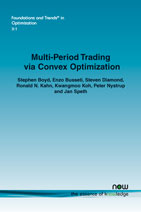Multi-Period Trading via Convex Optimization
By Stephen Boyd, Stanford University, USA, boyd@stanford.edu | Enzo Busseti, Stanford University, USA, ebusseti@stanford.edu | Steve Diamond, Stanford University, USA, stevend2@stanford.edu | Ronald N. Kahn, Blackrock, USA, ron.kahn@blackrock.com | Kwangmoo Koh, Blackrock, USA, kwangmoo.koh@blackrock.com | Peter Nystrup, Technical University of Denmark, Denmark, pnys@dtu.dk | Jan Speth, Blackrock, USA, jan.speth@blackrock.com
Abstract
We consider a basic model of multi-period trading, which can be used to evaluate the performance of a trading strategy. We describe a framework for single-period optimization, where the trades in each period are found by solving a convex optimization problem that trades off expected return, risk, transaction cost and holding cost such as the borrowing cost for shorting assets. We then describe a multi-period version of the trading method, where optimization is used to plan a sequence of trades, with only the first one executed, using estimates of future quantities that are unknown when the trades are chosen. The single period method traces back to Markowitz; the multi-period methods trace back to model predictive control. Our contribution is to describe the single-period and multi-period methods in one simple framework, giving a clear description of the development and the approximations made. In this paper, we do not address a critical component in a trading algorithm, the predictions or forecasts of future quantities. The methods we describe in this paper can be thought of as good ways to exploit predictions, no matter how they are made. We have also developed a companion open-source software library that implements many of the ideas and methods described in the paper.
Multi-Period Trading via Convex Optimization
Multi-Period Trading via Convex Optimization considers a basic model of multi-period trading, which can be used to evaluate the performance of a trading strategy. It describes a framework for single-period optimization, where the trades in each period are found by solving a convex optimization problem that trades off expected return, risk, transaction cost and holding cost such as the borrowing cost for shorting assets. It then describes a multi-period version of the trading method, where optimization is used to plan a sequence of trades, with only the first one executed, using estimates of future quantities that are unknown when the trades are chosen. The single period method traces back to Markowitz; the multi-period methods trace back to model predictive control. This monograph addresses the single-period and multi-period methods in one simple framework, giving a clear description of the development and the approximations made. The methods described can be thought of as good ways to exploit predictions, no matter how they are made.
Multi-Period Trading via Convex Optimization collects in one place the basic definitions, a careful description of the model, and discussion of how convex optimization can be used in multi-period trading, all in a common notation and framework. It provides the reader with a unified, self-contained treatment, focusing on the practical issues that arise in multi-period trading. It will benefit anyone interested in the study of these methods and is also an ideal reference for a quantitative trader, or someone who works with or for, or employs, one.
